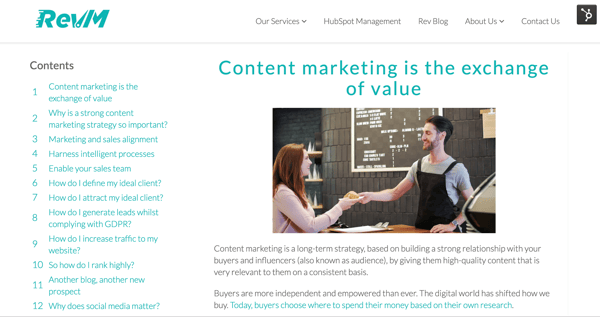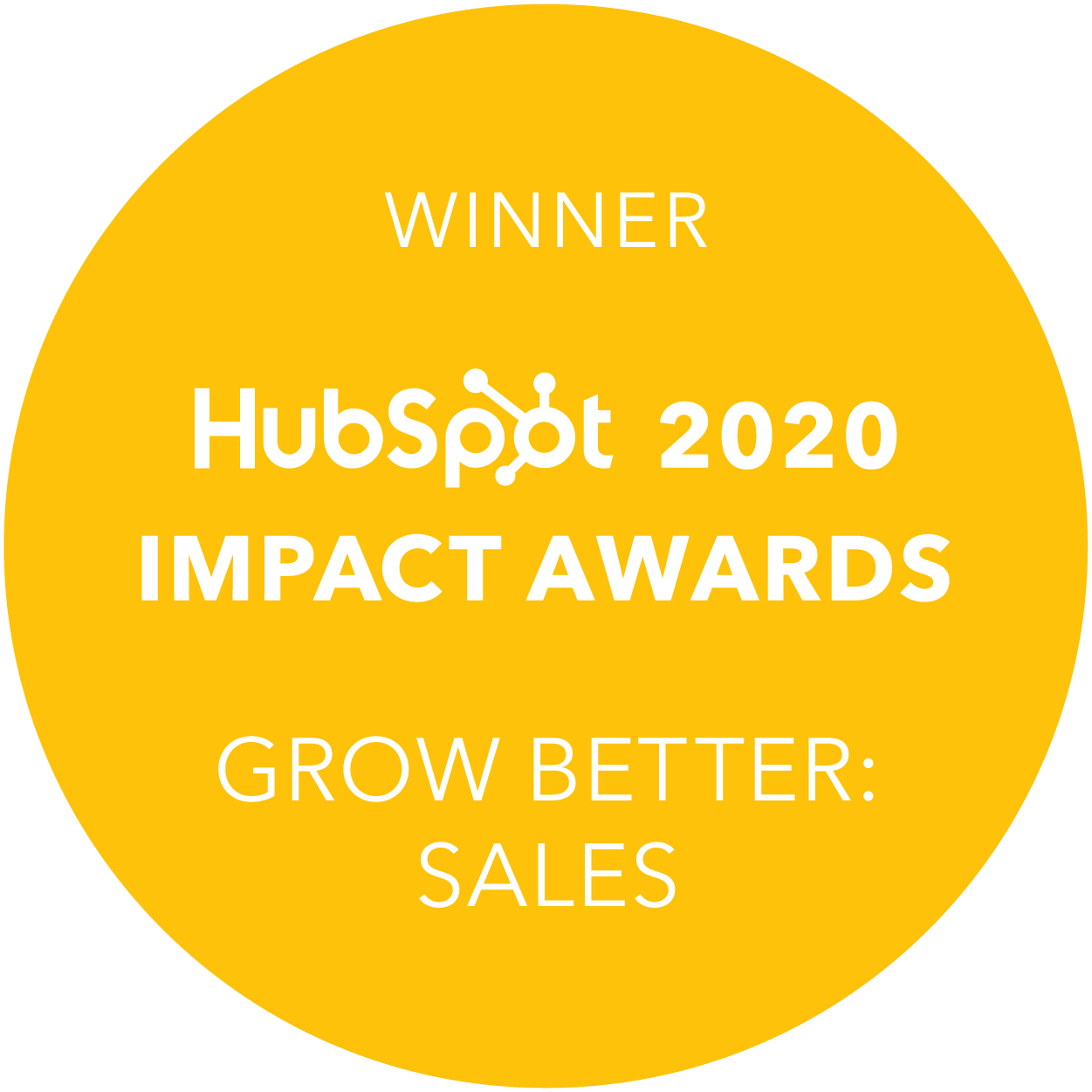“We need to create pillar page you say?”, eyes glazed over whilst you nod with vague approval. “What on earth is a pillar page!?”, you think to yourself.
Naturally, you turn straight to Google, click the first link, and as if by magic, a beautiful long webpage of helpful content appears before your eyes. It’s a pillar page and it reveals everything you need to know about pillar pages!
You scroll in awe at the helpfulness of this page. A hyperlinked table of contents navigates you to each chapter of the pillar page. Each chapter includes a bitesize breakdown of the important aspects of the main topic.
Already sold on the helpfulness of this page, you hastily add it to your bookmarks and proceed to scroll further. You discover that the text within each chapter links to a blog article that dives even deeper into the subsection’s content. Upon clicking through to a blog you learn that;
“A pillar page is a comprehensive un-gated guide that details one main topic in-depth while linking to relevant and useful content created to dig into subtopics within the pillar theme.”
Why do I need pillar pages?
Your online journey above demonstrates not only how human search behaviours have changed, but also how technology used to interpret and serve up search results have adapted. There exists an overwhelming amount of content online, with much of it serving little value or relevancy to us.
As a result, users are no longer using keywords to navigate their search results. Instead, they are leveraging longer-form search queries in an effort to filter out irrelevant information and generate more focused results, faster. The rise of voice search features has contributed to this conversational online behaviour and led to a need for change in how Google and others rank content.
This is good news for users, who by virtue of Google are now able now able to find answers to the most abstract questions imaginable ("where is a good place to eat around here?"). It does however, mean that we as marketers have to work harder. So let's begin!
What are topic clusters?
Search engines are now focused on topic clusters. "These are themes of related, relevant information that address multiple aspects of one subject using one large piece of content and supporting content pieces that link to it." (HubSpot, 2017)
Since it is your goal to help users find exactly what they are looking for, now your focus needs to shift towards covering one broad topic and answering all of the related questions that arise out of each of those sub-topics. Doing so will ensure you're combining as many long-tail keywords as possible.
Take RevM for instance. As a Platinum HubSpot Marketing Agency, it's our job to create quality content about every inbound marketing topic under the sun: marketing automation, content marketing, HubSpot optimisation, and more.
While all that content falls under the umbrella category of "inbound marketing", we deal with multiple sub-branches of digital marketing that correspond to that. Hence, we create content around each category that relates to inbound marketing, such as email automation, social selling, buyer personas etc. Pillar page's are what unites each of those categories.
What is a pillar page?
Here’s our pillar page about ‘Content Marketing’. We wanted to rank for topics related to content marketing. So we created a comprehensive guide that generally covers everything you need to know about executing a strong content marketing strategy; "How to align sales and marketing teams", "how to define and attract your ideal buyers and "how to nurture leads through the customer life cycle". Then we hyperlinked each of those sub-topics to blogs we have written under those sub-headings - like this post about ‘How to nail your inbound video marketing strategy’, which dives into even more detail on the subject than the pillar page does.
Essentially, pillar pages should answer any question or query your buyers might have about a topic that you cover. To compel users to click on your pillar page, it has to be the holy grail of everything they've ever needed to know about a particular search term that your page ranks for. Once they click into your pillar page to get the answers to their questions, they can click through to more specific pieces of cluster content hyperlinked on the pillar page. It's one of the most effective SEO tools at your finger tips and it's a great way to keep users on your site for longer as they navigate through multiple pages.
How do I create a pillar page?
Step 1: Decide on the topics you want to rank for
If you want to create a pillar page the first thing you need to do is choose all of the topics you want your website to rank for and then brainstorm specific keywords related to that theme or topic.
This is when it pays to have effectively conducted your buyer persona research. Leverage the information you have gleaned about your ideal buyers to define the top interests and challenges of your core audience. This will give you ideas for the pillar page content and help you to structure your 101 guide to content Nirvana. For instance, we run a blog that discusses inbound marketing. So, we could write our next pillar page on marketing automation, since that is a broad topic that we need to educate our audience about.
Be careful not to be too broad in your choice of topic. If there's too much information to cover on one particular topic your pillar page will lack a clear focus and be too overwhelming for the user. In our case, “marketing” was far too broad of a topic for us to cover. There is an abundance of subtopics that could come out of this. Equally, don't choose a topic that is too narrow. For us, writing a pillar page on the topic of “list segmentation” for example would not give us enough content to write about. Rather, that topic would lend itself better to a blog. The sweet-spot is somewhere in the middle. “Marketing automation”, for example, is a topic that presents enough opportunities for us to educate our target buyers about, without narrowing our focus too thin.
Step 2: Choose the keywords you’ll target
It's important to do some keyword research before writing your pillar page. Google is your best friend here to work out how many people are searching for keywords you want to rank for and what topics you need to cover. Type in your niche in the search bar and look at the most commonly searched results.
The more relevant phrases you pepper throughout your pillar page, the more blog posts you'll have ready to write in the future, and the easier linking to those blog posts will be.
Step 3: Write your pillar page powerhouse!

Take a look at one of our pillar pages. It has hyperlinked chapter headings that, when clicked, bring you to the corresponding section of the content. The idea is to make the users journey as simple as possible. You'll want to do the same for your readers.
Typically, your pillar page will be the longest pieces of content on your site. Therefore, structure and layout are integral to ensuring your readers can scan it quickly. People don't read pillar pages like they read novels (unfortunately). They come to answer a specific question. It's your job to help them answer that question, either in the content you create on the pillar page or in one of the blogs that links out from it. Break up each section with subheadings and use images. This will make the content easily digestible and leave your reader's hungry for more!
Conclusion
Congratulations! You can now go back to your boss and tell him/her that you think it's a fantastic idea to create a pillar page. If you ever catch yourself trying to explain what a pillar page is, think of them as the "pillar" of the rest of your content. The SEO powerhouse that holds all of your content together to make the users journey better.

.png?width=200&height=67&name=RevM%20Digital%20Marketing%20Agency%20Woking%20Surrey%20(1).png)







